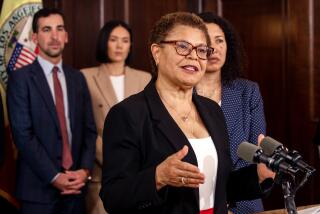Op-Ed: California’s public unions have too much clout and compensation
- Share via
Mayor Eric Garcetti, a pro-labor Democrat, has tried to restore ties with Los Angeles’ public employee unions after most of them backed his opponent in the 2013 mayoral race. Nevertheless, the mayor is sticking with the hard line he has taken in contract talks: asking city workers to accept a three-year wage freeze, pay 10% of their healthcare premiums (many currently pay nothing) and accept a higher retirement age.
Garcetti has joined a growing list of Democratic mayors who have locked horns with their cities’ unions. This reflects a fissure at the heart of the urban Democratic coalition. Until the recession, public employee unions were its most powerful component. Since then, however, exploding compensation costs, especially pensions and healthcare, have forced some Democratic politicians to recalculate that alliance.
The big problem in California in general and Los Angeles in particular is the rising cost of government employment. According to economists Andrew Biggs and Jason Richwine, California is among the few states where public employees make as much as 20% more in total compensation than comparable private sector employees.
To a substantial extent, these compensation premiums are driven by the rising costs of public employee pensions and healthcare. In Los Angeles, pension costs have risen to nearly 20% of the city’s budget from 3% in 2000. Statewide pension liabilities are increasing at a rate of $17 billion a year, which make the state’s current cash surplus a mirage.
As the city and state pay more for public services they’ve already consumed, there are fewer resources left for other public priorities. Government ends up spending more but doing less, which is a governing formula that pleases neither liberals nor conservatives.
What is to be done?
The pension reform options are relatively well known. They involve steep cuts in future benefits for new hires by rejiggering pension formulas, which define what percentage of a worker’s final salary (usually calculated over their last three to five working years) will be replaced in retirement. More promising alternatives involve offering 401(k)-style plans for at least some new workers, which take liabilities off the government’s books.
However, changing the current mode of deferred compensation for public workers has met with fierce opposition from California’s powerful public employee unions. Representing about 63% of California’s public employees, these unions are among the most powerful interest groups in the state. They are among the largest contributors to politicians’ campaign coffers and among the state’s largest lobbying spenders. Because the unions are deeply embedded in the dominant Democratic Party, they have effectively tied the hands of legislators to address the rising legacy costs.
California’s state and local governments therefore face a political conundrum. They cannot pass pension reform over the unions’ objections, but they’ve been unwilling to try to diminish the main obstacle to reform.
Admittedly, it would be a formidable hurdle to reduce the political power of the state’s public sector unions. But doing so would free up the space politically to address the pension crisis and pay handsome dividends long-term by reducing the costs and increasing the productivity of California government. In fact, this is the logical next step to what Garcetti is doing.
Reducing the unions’ political advantages would require steps to make public sector unions more like other interest groups. The state could eliminate so-called fair share fees (the money nonmembers pay to the union for representation in collective bargaining), stop the payroll deduction of such fees and dues, and require the unions to hold periodic recertification elections to test whether workers actually want to be represented by a union. Call it a race to equity as each of these steps, taken individually or in combination, would help level the interest group playing field.
Unless elected officials decide that they can indefinitely raise taxes or are willing to see government productivity erode, they must confront their union allies one way or another. In that respect, Garcetti may be ahead of the curve.
And in the long run, the unions too have a choice: accept serious pension reform and keep their political power or potentially lose on both counts.
The U.S. Supreme Court may do the politicians’ dirty work. If it decides to hear Friedrichs vs. CTA, a case coming out of California, and extends the logic Justice Samuel A. Alito Jr. has laid out in recent cases, it could declare a national “right to work” law for the public sector. Now, if a workplace is unionized, workers are required to join or pay dues. Undoing that could create the political space for serious pension reform.
For now, California has created a version of liberalism in which almost two-thirds of its income tax revenue go toward paying for public services already rendered in the form of generous pensions and healthcare for public employees who constitute only 14% of the labor force. The private sector middle class reaps few dividends as its taxes decreasingly pay for government programs citizens need here and now.
Daniel DiSalvo is an assistant professor of political science in the Colin Powell School for Civic and Global Leadership at the City College of New York-CUNY and a senior fellow at the Manhattan Institute for Policy Research. His new book is “Government Against Itself: Public Union Power and Its Consequences.”
Follow the Opinion section on Twitter @latimesopinion and Facebook
More to Read
A cure for the common opinion
Get thought-provoking perspectives with our weekly newsletter.
You may occasionally receive promotional content from the Los Angeles Times.









